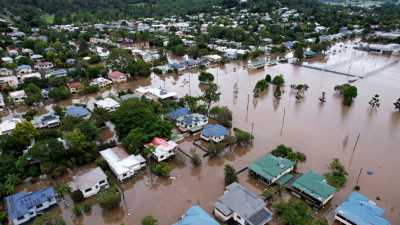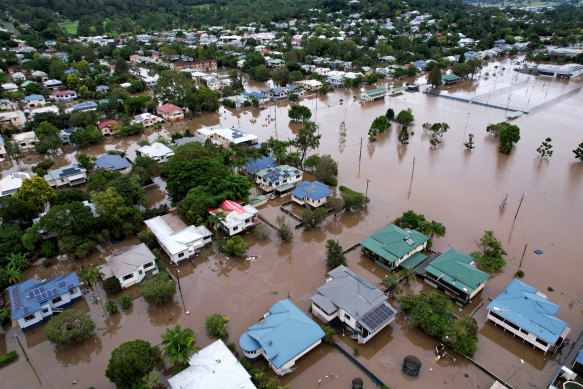‘Black hole’: Insurers warn of unaffordable premiums, home risks

Save articles for later
Add articles to your saved list and come back to them any time.
Australia’s insurance giants are warning premium costs will spiral beyond the reach of more households unless some homes are relocated from high-risk areas and planning laws are improved to better consider natural disasters.
Insurance Australia Group (IAG), Suncorp and QBE have put the spotlight on rising premiums and point to locations like Wilberforce, Emu Plains and Warwick Farm in Sydney’s basin where planning controls fail to deal with unacceptable residual flood risk.
Insurers say land-planning regulations must properly account for natural disaster risks to avoid putting houses in harm’s way.Credit: Getty
The House of Representatives committee inquiry into insurers’ responses to last year’s east-coast flooding disaster – the most expensive insurance event in the nation’s history with $7.4 billion in claims – received 17 submissions including from the nation’s biggest insurers.
Speaking ahead of an IAG land-planning report to be released on Monday, the insurer’s land planning hazards and regulatory manager Andrew Dyer said houses are being approved in areas under the current planning framework where natural disaster risk levels are unacceptably high.
“We’ve got to stop putting more people’s assets in harm’s way, and this is really through land planning reform,” he said. “That’s where your biggest bang for buck is.”
For a new $500,000 house in Wilberforce, the flood insurance premium is roughly $3700, or about 3.2 per cent of the area’s median household income, the report says. That does not include other typical charges like non-flood “base premiums” which can boost the total cost to around $6200 making it unaffordable for many.
Dyer said current views on “acceptable risk” in land planning don’t adequately factor in natural disasters leaving some communities with “really unacceptable financial outcomes”.
Other localities lack national guidance for planned relocations, he said.
“The risk in some areas is approaching levels where you’re not talking about insurance availability or affordability,” he said. “You’re really talking about the habitability and viability of these communities. There is no national guidance currently on planned relocation, and we think that’s a bit of black hole.”
In its submission to the inquiry, Suncorp said Australia’s current built environment is dealing with the consequence of decades of poor planning and more government support and investment is needed for mitigation efforts.
“Increasingly, the likelihood is that more properties will only be insurable at a cost beyond the reach of most homeowners,” the company said. “Affordable insurance and the backstop of government have always been there to deal with the consequences. [But] the evolving risk appetite of global reinsurers, combined with the recognition of a changing climate, has rendered this traditional model obsolete.”
Suncorp said the task was “too big for any individual government,” but outlined the benefit of investing in mitigation measures calling out the levies rebuilt by the three levels of government in Tasmania around 2010.
“When Launceston was subject to a major flood in 2016, it was estimated the $55 million upgrade of the levee system avoided economic losses of $216 million,” the group said. “The Bushfire and Natural Hazards Co-operative Research Centre (CRC) estimates this was a saving four-times the investment in the levees.”
Suncorp also highlights the need for enhanced building codes and better planning to stop communities from being put at risk, as well as grants for property owners to make dwellings more resilient.
QBE said insurers’ risk maps, models and tools need to improve for premiums to accurately reflect infrastructure improvements made by communities. “The Queensland Household Resilience Program is an example of this, and we would welcome a similar approach in other government-funded mitigation programs,” the company said.
Dyer said while insurers tended to become involved at the end of the lifecycle of an asset such as a home, they could do better by feeding back their insights into the decision-making process of where to build communities. “What we’re talking about here is getting involved earlier in the lifecycle of the asset and influencing the risk,” he said.
The Business Briefing newsletter delivers major stories, exclusive coverage and expert opinion. Sign up to get it every weekday morning.
Most Viewed in Business
From our partners
Source: Read Full Article
